Ophiuchus constellation lies in the southern sky, on the celestial equator. Its name means “the serpent bearer” in Greek.
It is pronounced /ˌɒfiːˈjuːkəs/ (off-ee-YOO-cuss). The constellation is associated with the figure of Asclepius, the famous healer in Greek mythology. It was one of the constellations first catalogued by the Greek astronomer Ptolemy in the 2nd century. Sometimes, it is also known by its Latin name, Serpentarius. Ophiuchus is generally depicted as a man holding a snake, represented by the neighboring constellation Serpens, which is divided into two parts by Ophiuchus: Serpens Caput, the snake’s head, and Serpens Cauda, the snake’s tail. The snake is usually depicted coiled around his waist.
Even though Ophiuchus is one of the constellations that cross the ecliptic and there have been attempts to include it among the signs of the zodiac, it does not belong to the Zodiac family, but to the Hercules family of constellations.
Ophiuchus contains a number of notable stars, including Rasalhague and Barnard’s Star, and many famous deep sky objects, including Kepler’s Supernova, the Twin Jet Nebula, the Little Ghost Nebula, the Double Helix Nebula, the dark nebulae Barnard 68, the Pipe Nebula, the Snake Nebula, the Cosmic Bat Nebula and the Dark Horse Nebula, and the globular clusters Messier 9, Messier 10, Messier 12, Messier 14, Messier 19, Messier 62, and Messier 107.
Facts, location and map
Ophiuchus is the 11th largest constellation in the sky, occupying an area of 948 square degrees. It is one of the 15 equatorial constellations. It is located in the third quadrant of the southern hemisphere (SQ3) and can be seen at latitudes between +80° and -80°. The neighboring constellations are Aquila, Hercules, Libra, Sagittarius, Scorpius and Serpens.
The constellation name Ophiuchus is pronounced /ˌɒfiˈjuːkəs/. In English, the constellation is known as the Serpent Bearer. The genitive form of Ophiuchus, used in star names, is Ophiuchi (pronunciation: /ˌɒfiˈjuːkaɪ/). The three-letter abbreviation, adopted by the International Astronomical Union (IAU) in 1922, is Oph.
The brightest star in the constellation is Rasalhague, Alpha Ophiuchi, with an apparent magnitude of 2.08. There are four meteor showers associated with the constellation: the Ophiuchids, the Northern May Ophiuchids, the Southern May Ophiuchids and the Theta Ophiuchids.
Ophiuchus belongs to the Hercules family of constellations, along with Aquila, Ara, Centaurus, Corona Australis, Corvus, Crater, Crux, Cygnus, Hercules, Hydra, Lupus, Lyra, Sagitta, Scutum, Sextans, Serpens, Triangulum Australe and Vulpecula.
Ophiuchus contains seven Messier objects: Messier 9 (M9, NGC 6333), Messier 10 (M10, NGC 6254), Messier 12 (M12, NGC 6218), Messier 14 (M14, NGC 6402), Messier 19 (M19, NGC 6273), Messier 62 (M62, NGC 6266) and Messier 107 (M107, NGC 6171). It also has seven stars with known planets.
The constellation contains 13 named stars. The proper names of stars that have been officially approved by the International Astronomical Union (IAU) are Bake-eo (Bake Eo), Barnard’s Star, Cebalrai, Guniibuu, Mahsati, Marfik, Orkaria, Rasalhague, Rosalíadecastro, Sabik, Timir, Yed Posterior, and Yed Prior.
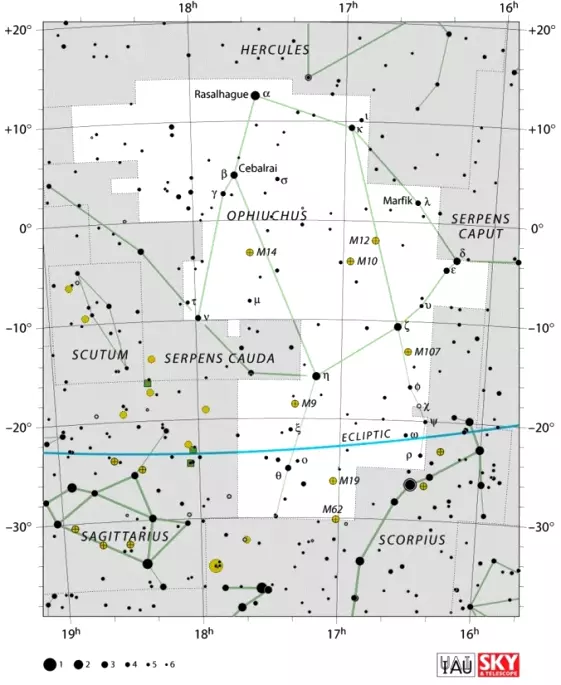
Ophiuchus constellation map by IAU and Sky&Telescope magazine
Myth
Ophiuchus is most frequently associated with the Greek mythical figure of Asclepius, son of the god Apollo, who was said to be able to bring people back to life with his healing powers. Asclepius learned how to do this after seeing one snake bringing healing herbs to another. This happened when Glaucus, the son of King Minos of Crete, fell into a jar of honey and drowned. Asclepius saw a snake slithering toward his body and did away with it. Then another snake came along and placed a herb on the first one, which miraculously brought the first snake back to life. Asclepius saw this and took the same herb and placed it on Glaucus’ body. The king’s son was miraculously resurrected.
Asclepius was raised by Chiron, the wise centaur, associated with Centaurus constellation, who taught him the art of healing. In one of the myths, Asclepius was given the blood of the Gorgon Medusa by the goddess Athene. The Gorgon’s blood from the veins on her left side was poison, but the blood from the veins on the right side was said to be able to bring people back to life.
In another tale, Asclepius resurrected Theseus’ son Hippolytus after the king’s son was thrown from his chariot. In this version of the myth, Hippolytus is associated with Auriga constellation, the charioteer.
The healer was struck down by Zeus because the god was worried that the human race would become immortal with Asclepius around to heal them. Zeus’ brother Hades, the god of the Underworld, was concerned that the flow of souls into his domain would dry up as a result of Asclepius’ healing ability. Hades complained about this to Zeus and the thunder god struck the healer down with a bolt of lightning. Zeus later placed Asclepius’ image in the sky to honour his gift and good deeds. The healer became the constellation Ophiuchus, the Serpent Bearer.
Ophiuchus constellation may be descended from an ancient Babylonian constellation that represented the serpent-god Nirah, who was sometimes depicted as a hybrid being, with a human head and torso, and serpents for legs. This theory, however, has not been confirmed by sufficient evidence.
The constellation got a notable mention in John Milton’s Book 2 of Paradise Lost, in which Satan was compared to a comet “that fries the length of Ophiuchus huge/In th’ arctic sky.”
Ophiuchus stars
Rasalhague – α Ophiuchi (Alpha Ophiuchi)
Rasalhague (or Ras Alhague) is the brightest star in Ophiuchus. It has an apparent magnitude of 2.07 and is approximately 48.6 light years distant from Earth. It is a binary star with an orbital period of 8.62 years.
The primary component in the system is a white giant star with the stellar classification A5 III. It has a mass 2.4 times that of the Sun. The companion is an orange main sequence dwarf (K5-7 V) with 85 percent of the Sun’s mass.
The brighter component is about 25 times more luminous than the Sun. It is a very fast spinner, with a projected rotational velocity of 240 km/s. As a result, it has an equatorial bulge that is about 20 percent larger than the polar radius, which gives Alpha Ophiuchi the shape of an oblate spheroid.
The star’s traditional name, Rasalhague, is derived from the Arabic raʾs al-ḥawwἄ, which means “the head of the serpent collector.” The star marks Asclepius’ head.
Sabik – η Ophiuchi (Eta Ophiuchi)
Sabik, Eta Ophiuchi, is the second brightest star in the constellation. It has a combined visual magnitude of 2.43 and is approximately 88 light years distant from the Sun. It is a binary star that is not easy to resolve in smaller telescopes. The system is composed of two white main sequence dwarfs belonging to the spectral classes A1 V and A3 V. They have an orbital period of 87.58 years. The stars have apparent magnitudes of 3.05 and 3.27.
ζ Ophiuchi (Zeta Ophiuchi)
Zeta Ophiuchi is the third brightest star in Ophiuchus. It is an exceptionally large blue main sequence star with the stellar classification of O9.5 V. It has an apparent magnitude of 2.569 and is about 366 light years distant from the solar system.
The star is classified as a Beta Cephei variable, a star that exhibits variations in brightness as a result of pulsation of its surface. Within the next few million years, the star will expand into a red supergiant and likely go out as a supernova, leaving behind a pulsar or neutron star.
Zeta Ophiuchi has 8 times the Sun’s radius and more than 19 solar masses. It is a fast rotating star, spinning close to the velocity at which it could begin to break up. Its projected rotational velocity may be as high as 400 km/s. The star’s estimated age is only 3 million years.
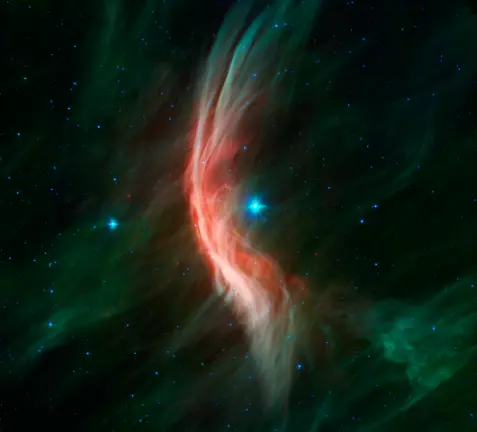
Zeta Ophiuchi – Like a ship plowing through cosmic seas, runaway star Zeta Ophiuchi produces the arcing interstellar bow wave or bow shock seen in this stunning infrared portrait. In the false-color view, bluish Zeta Oph, a star about 20 times more massive than the Sun, lies near the center of the frame, moving toward the left at 24 kilometers per second. Its strong stellar wind precedes it, compressing and heating the dusty interstellar material and shaping the curved shock front. Around it are clouds of relatively undisturbed material. What set this star in motion? Zeta Oph was likely once a member of a binary star system, its companion star was more massive and hence shorter lived. When the companion met it end as a supernova dramatically losing mass, Zeta Oph was flung out of the system. About 460 light-years away, Zeta Oph is 65,000 times more luminous than the Sun and would be one of the brighter stars in the sky if it weren’t surrounded by obscuring dust. The image spans about 1.5 degrees or 12 light-years at the estimated distance of Zeta Ophiuchi. Image: NASA, JPL-Caltech, Spitzer Space Telescope
Yed Prior – δ Ophiuchi (Delta Ophiuchi)
Delta Ophiuchi is a red giant with the stellar classification of M0.5 III. It is the fourth brightest star in the constellation. It has an apparent magnitude of 2.75 and is approximately 171 light years distant from the Sun.
It forms an optical double with the star Epsilon Ophiuchi, or Yed Posterior. The word “yed” comes from Arabic and means “the hand.” The two stars mark the left hand of the Serpent Bearer, which holds the head of the serpent.
Delta Ophiuchi has a mass 1.5 times that of the Sun and a radius about 59 times solar. It is a suspected variable star with possible variations in magnitude by 0.03.
Cebalrai – β Ophiuchi (Beta Ophiuchi)
Beta Ophiuchi is an orange giant star belonging to the spectral class K2 III. It is the fifth brightest star in the constellation. It has a visual magnitude that ranges from 2.75 to 2.77 and is 81.8 light years distant from Earth. The star’s traditional name, Cebalrai (and variants Cheleb and Kelb Alrai) comes from the Arabic kalb al-rā‘ī, which means “the shepherd dog.”
Cebalrai has 113 percent of the Sun’s mass and a radius 12.42 times solar. The star is 63.4 times more luminous than the Sun. It has an unconfirmed planetary companion in its orbit.
κ Ophiuchi (Kappa Ophiuchi)
Kappa Ophiuchi is another suspected variable star in Ophiuchus. It is an orange giant with the stellar classification of K2 III. It has a mean apparent magnitude of 3.20 and is 91.5 light years distant from the Sun.
Kappa Ophiuchi has 119 percent of the Sun’s mass and 11 times the solar radius. It is 46 times more luminous than the Sun.
Yed Posterior – ε Ophiuchi (Epsilon Ophiuchi)
Epsilon Ophiuchi is a yellow giant star belonging to the spectral class G9.5 IIIb. It has a visual magnitude of 3.220 and is 106.4 light years distant from the solar system. It is 1.85 times more massive than the Sun and has a radius 10.39 times solar. The star is 54 times more luminous than the Sun. Its estimated age is about a billion years.
θ Ophiuchi (Theta Ophiuchi)
Theta Ophiuchi is a multiple star system that marks Ophiuchus’ right foot. It has an apparent magnitude of 3.26 and is approximately 436 light years distant from the solar system.
The primary component in the system is a spectroscopic binary with the stellar classification of B2 IV, matching the spectrum of a blue-white subgiant star. It is 5,000 times more luminous than the Sun. The star is classified as a Beta Cephei variable.
Sinistra – ν Ophiuchi (Nu Ophiuchi)
Nu Ophiuchi is an orange giant with the stellar classification of K0 IIIa CN-1. It has an apparent magnitude of 3.332 and is approximately 151 light years distant from the Sun. The star is three times more massive than the Sun, has 14 times the solar radius, and is 123 times more luminous than the Sun.
A brown dwarf was discovered orbiting the star in early 2004. The dwarf has a mass at least 21.9 times that of Jupiter and orbits the star with a period of 536 days. In 2010, another brown dwarf companion was discovered, one with at least 24.5 Jupiter masses and an orbital period of 3,169 days.
The star’s traditional name, Sinistra, means “the left side” in Latin.
Bake Eo – γ Ophiuchi (Gamma Ophiuchi)
Gamma Ophiuchi is a white main sequence dwarf of the spectral type A0 V. It has a visual magnitude of 3.75 and is 102.8 light years distant from Earth. The star’s estimated age is about 184 million years.
Gamma Ophiuchi has a mass 2.9 times that of the Sun, a radius 1.8 times solar, and is 29 times more luminous than the Sun. The star is a fast spinner, with a projected rotational velocity of 220 km/s. It is radiating an excess emission of infrared, which indicates the presence of a circumstellar disk of dust in its orbit.
In 2024, the International Astronomical Union (IAU) formally approved the name Bake Eo (or Bake-eo) for the star. It is the star’s traditional name in the Marshall Islands. Bake is the spondylus mussel and eo means “here it is, take it.”
Marfik – λ Ophiuchi (Lambda Ophiuchi)
Marfik, Lambda Ophiuchi, is a triple star system in Ophiuchus. It has a combined apparent magnitude of 3.90 and is about 170 light years distant from the solar system. The star’s traditional name, Marfik, means “the elbow” in Arabic.
Lambda Ophiuchi is a suspected variable. It has the stellar classification A0V+A, matching the spectrum of a white main sequence dwarf.
67 Ophiuchi
67 Ophiuchi is a blue-white supergiant with the stellar classification of B5Ib. It has an apparent magnitude of 3.93 and an absolute magnitude of -4.26. The star is approximately 1,400 light years distant from Earth. It is a member of the open cluster Collinder 359.
70 Ophiuchi
70 Ophiuchi is a binary star in Ophiuchus. It is only 16.58 light years distant from the Sun. The primary component in the system is an orange dwarf with the stellar classification of K0V. It has an apparent magnitude of 4.03. It is classified as a BY Draconis type variable, a star showing variations in brightness as a result of rotation coupled with star spots and other chromospheric activity.
The companion is another orange dwarf. It has the stellar classification K4V and an apparent magnitude of 6.00. The two stars have an orbital period of 88.3 years.
χ Ophiuchi (Chi Ophiuchi)
Chi Ophiuchi has the stellar classification of B2Vne. It is a Be star, a star that radiates emissions from hydrogen which are indicative of a circumstellar ring of gas. It has an apparent magnitude that ranges from 4.18 to 5.0 and is classified as a Gamma Cassiopeiae type variable.
The star has a mass 10.1 times that of the Sun and a radius 4.5 times solar. It is 200,000 times more luminous than the Sun. Its estimated age is 22.5 million years.
36 Ophiuchi
36 Ophiuchi is a triple star system only 19.5 light years from Earth. The three stars have apparent magnitudes of 5.29, 5.33 and 6.34. All three are orange dwarfs and have stellar classifications of K0 V, K1 V, and K5 V. The primary and secondary components are separated by 4.6 seconds of arc, and the tertiary star is separated from the main pair by 700 arc seconds. The third component is classified as an RS Canum Venaticorum variable, a close binary star with an active chromosphere that can cause large stellar spots, which in turn cause variations in brightness.
51 Ophiuchi
51 Ophiuchi is a blue-white giant star belonging to the stellar class B9.5IIIe. It has a visual magnitude of 4.81 and is approximately 410 light years distant from the solar system. The star has a disk of dust that seems to be a young debris disk, likely a planetary system entering the last stage of planet formation.
12 Ophiuchi
12 Ophiuchi is an orange main sequence dwarf with the stellar classification of K2V. It has an apparent magnitude of 5.77 and is 31.8 light years distant from the Sun. It is classified as a BY Draconis type variable.
12 Ophiuchi has 91 percent of the Sun’s mass, 84 percent of the solar radius, and only 39 percent of the Sun’s luminosity. It was one of the top 100 target stars for the Terrestrial Planet Finder mission before the mission was postponed indefinitely.
Barnard’s Star
Barnard’s Star is a red dwarf with the stellar classification of M4Ve. It has a visual magnitude of 9.54 and is only 5.980 light years distant from Earth. It is the fourth closest known individual star to the Sun. The only known stars that are closer to us are the three components of the Alpha Centauri system in Centaurus constellation. The star is too faint to be seen without a telescope.
Barnard’s Star was named after the American astronomer E. E. Barnard, who was the first to measure the star’s proper motion in 1916. The star has the largest proper motion of any star relative to the Sun, 10.3 arc seconds per year. Around the year 9,800, the star will make its closest approach to the Sun and come within 3.75 light years.
Barnard’s Star has an estimated age of 7 to 12 billion years. Despite its age, the star has been seen exhibiting an intense stellar flare, in 1998, which earned it the classification as a flare star. It is also classified as a BY Draconis variable.
GJ 1214
GJ 1214 is a red dwarf with the stellar classification of M4.5. It has a visual magnitude of 14.71 and is 47.5 light years distant from Earth. The star has only 15.7 percent of the Sun’s mass and 20 percent of the solar radius.
A transiting extrasolar planet was discovered orbiting the star in December 2009. The planet has 6.55 Earth masses and completes an orbit around the star every 1.58 days.
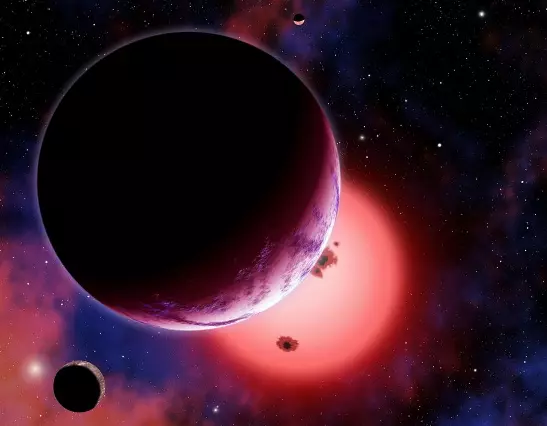
The planet GJ 1214b, shown here in an artist’s conception with two hypothetical moons, orbits a “red dwarf” star 40 light-years from Earth. GJ 1214b has a radius of about 2.7 times that of Earth and is about 6.5 times as massive, putting it squarely into the class of exoplanets known as super-Earths. An exoplanet is a planet that orbits a star beyond our sun. Image: CfA, David Aguilar; source: NASA.gov
Wolf 1061
Wolf 1061 is a red dwarf of the spectral type M3 V located in the Sun’s neighbourhood. It is only 13.82 light years distant and has an apparent magnitude of 10.10.
RS Ophiuchi
RS Ophiuchi is a recurrent nova in Ophiuchus. It has an apparent magnitude ranging from 9.6 to 13.5 in the quiet phase and reaching magnitude 5 during eruptions.
The system consists of a white dwarf and a red giant star in a close orbit. When enough material from the giant star builds up on the surface of the white dwarf – about every 20 years – the result is a thermonuclear event.
Eruptions were observed in 1898, 1933, 1958, 1967, 1985, and 2006. If the white dwarf accretes enough material to reach the Chandrasekhar limit, the maximum mass of a stable white dwarf star (1.4 solar mass), it will likely meet its end as a Type Ia supernova.
COROT-6
COROT-6 is a yellow-white main sequence dwarf with the stellar classification of F5V. It has a visual magnitude of 13.9 and roughly the same mass and radius as the Sun.
The star has a confirmed planet in its orbit. The planet, COROT-6b, has a mass 2.96 times that of Jupiter and completes an orbit around the star every 8.887 days.
Deep sky objects in Ophiuchus
Messier 9 (M9, NGC 6333)
Messier 9 is a globular cluster with an apparent magnitude of 8.42. It is approximately 25,800 light years distant from Earth.
It is one of the nearest globular clusters to the centre of our Galaxy, lying at a distance of 5,500 light years. The cluster was discovered by Charles Messier in 1764. The brightest stars in M9 have a visual magnitude of 13.5 and can be observed in moderately sized telescopes.
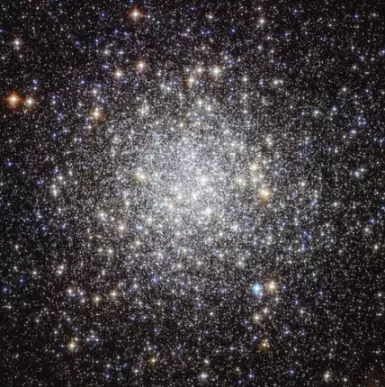
This image from the NASA/ESA Hubble Space Telescope shows the globular cluster Messier 9. Hubble’s image resolves stars right into the centre of the cluster, and clearly shows they have different colours. Redder colours signify lower surface temperatures, while blue stars are extremely hot. Image: NASA & ESA
Messier 10 (M10, NGC 6254)
Messier 10 is another globular cluster in Ophiuchus. It has an apparent magnitude of 6.4 and is approximately 14,300 light years distant from the Sun. It was discovered by Charles Messier on May 29, 1764, and subsequently included in his catalogue.
The cluster’s core is quite bright and spans about 35 light years across, and the cluster’s spatial diameter spans about 83 light years.
M10 lies about 16,000 light years from the Galactic Centre and completes an orbit around the Milky Way every 140 years.
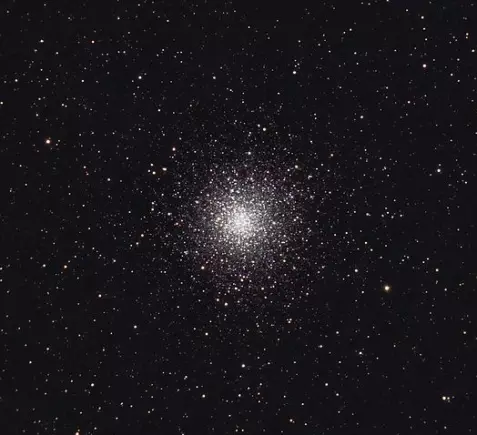
Messier 10, image: Wikimedia Commons/Hewholooks (CC BY-SA 3.0)
Messier 12 (M12, NGC 6218)
Messier 12 is also a globular cluster, also discovered by Messier in May 1764. It has an apparent magnitude of 7.68 and is about 15,700 light years distant from the solar system. It can be found about 3 degrees from Messier 10.
The cluster is about 75 light years in diameter, and the brightest stars in it are of 12th magnitude.
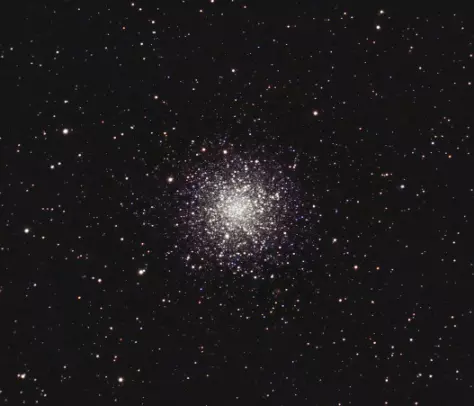
Messier 12, image: Wikimedia Commons/Hewholooks (CC BY-SA 3.0)
Messier 14 (M14, NGC 6402)
Messier 14 is another globular cluster, discovered by Messier in 1764. It is about 100 light years across. It has a visual magnitude of 8.32 and is 30,300 light years distant from Earth.
The cluster contains several hundreds of thousands of stars, the brightest of which are of 14th magnitude, and can easily be seen with binoculars.
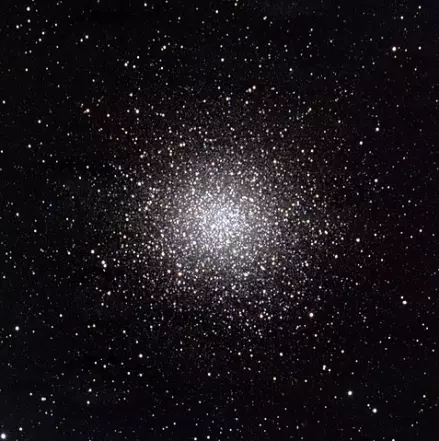
Messier 14, image: NOIRLAB / NSF / AURA (CC BY 4.0)
Messier 19 (M19, NGC 6273)
Messier 19 is a globular cluster with an apparent magnitude of 7.47. It is approximately 28,700 light years distant from the solar system.
The cluster was discovered by Charles Messier in June 1764. It lies 4.5 degrees to the west-southwest of the star Theta Ophiuchi and can be seen with binoculars. It is located only 6,500 light years from the Galactic Centre.
The estimated age of M19 is about 11.9 billion years.
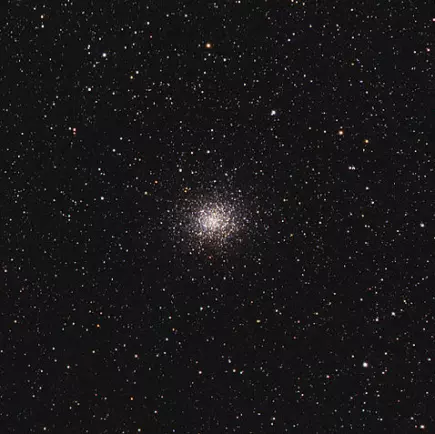
Messier 19, image: Wikimedia Commons/ Hewholooks (CC BY-SA 3.0)
Messier 62 (M62, NGC 6266)
M62 was discovered by Charles Messier in 1771. It is another globular cluster. It has an apparent magnitude of 7.39 and is about 22,200 light years distant. The cluster is approximately 100 light years across.
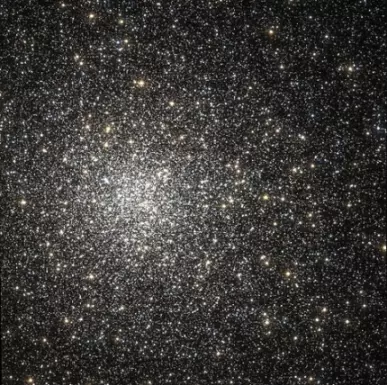
Messier 62, image: NASA and ESA (Hubble Space Telescope)
Messier 107 (M107, NGC 6171)
Messier 107 is the last globular cluster entered in Messier’s catalogue. It is a relatively loose cluster with an apparent magnitude of 8.85, approximately 20,900 light years distant from Earth.
The cluster was discovered by the French astronomer Pierre Méchain in April 1782, and then independently discovered by the German-born British astronomer William Herschel in 1793.
M107 was only added to the Messier catalogue in 1947, by the Canadian astronomer Helen Sawyer Hogg.
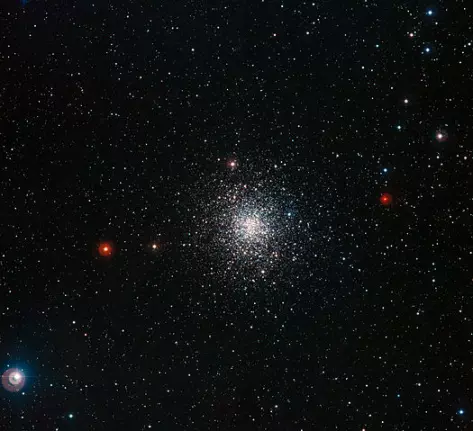
The globular cluster Messier 107, also known as NGC 6171, is located about 21 000 light-years away in the constellation of Ophiuchus. Messier 107 is about 13 arcminutes across, which corresponds to about 80 light-years at its distance. As is typical of globular clusters, a population of thousands of old stars in Messier 107 is densely concentrated into a volume that is only about twenty times the distance between our Sun and its nearest stellar neighbour, Alpha Centauri, across. This image was created from exposures taken through blue, green and near-infrared filters, using the Wide Field Imager (WFI) on the MPG/ESO 2.2-metre telescope at La Silla Observatory, Chile. Image: ESO/ESO Imaging Survey
Kepler’s Supernova – Supernova 1604
Kepler’s Supernova is a remnant of a supernova that was first observed in October 1604. The German mathematician and astronomer Johannes Kepler started observing the event in Prague on October 17 and tracked it for an entire year.
The supernova occurred approximately 20,000 light years from Earth and reached a peak magnitude of -2.25 to -2.5. It was brighter than all the stars and planets in the sky, and could be seen during the day for several weeks.
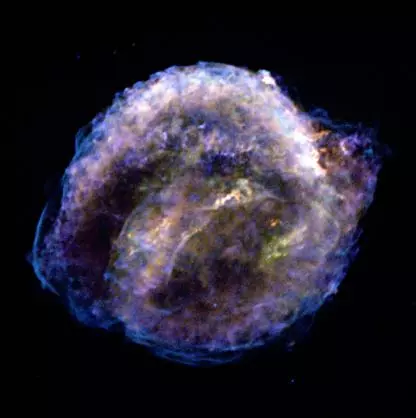
Kepler’s Supernova (Supernova 1604) – Using NASA’s Chandra X-ray Observatory, scientists have created a stunning new image of one of the youngest supernova remnants in the galaxy. This new view of the debris of a star helps astronomers solve a long-standing mystery, with implications for understanding how a star’s life can end dramatically and for gauging the expansion of the universe. Image: NASA
Supernova 17604 was the most recent supernova in the Milky Way that could be seen by the unaided eye.
NGC 6355
NGC 6355 is a globular cluster located approximately 31,000 light-years away. It has an apparent magnitude of 8.60 and an apparent size of 4.20 arcminutes. It was discovered by William Herschel on May 24, 1784.
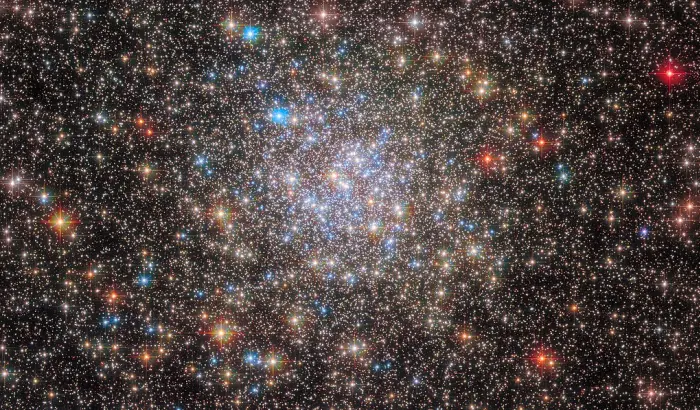
The scattered stars of the globular cluster NGC 6355 are strewn across this image from the NASA/ESA Hubble Space Telescope. This globular cluster lies less than 50,000 light-years from Earth in the Ophiuchus constellation. NGC 6355 is a galactic globular cluster that resides in our Milky Way galaxy’s inner regions. The dense, bright core of NGC 6355 was picked out in crystal-clear detail by Hubble in this image, and is the crowded area of stars towards the centre of this image. Image credit: ESA/Hubble & NASA, E. Noyola, R. Cohen, 2023 (CC BY 4.0)
Starfish Galaxy – NGC 6240
The Starfish Galaxy (NGC 6240) is an ultraluminous infrared galaxy (ULIRG) in Ophiuchus. It has an apparent magnitude if 12.8 and is about 400 million light years distant from the solar system. It is a remnant of a collision of two smaller galaxies, which has resulted in formation of a single larger galaxy. The galaxy has two nuclei, both active galactic nuclei (AGN), and a highly irregular structure.
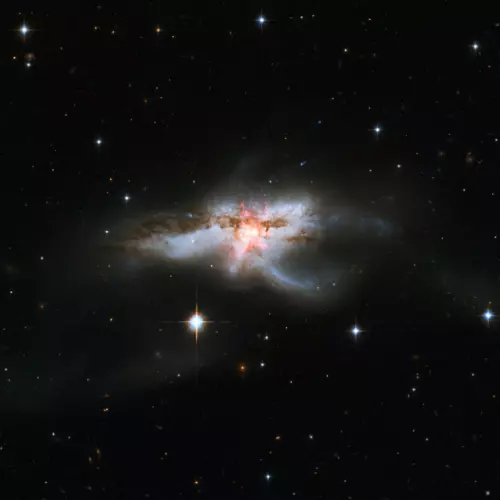
Not all galaxies are neatly shaped, as this new NASA/ESA Hubble Space Telescope image of NGC 6240 clearly demonstrates. Hubble previously released an image of this galaxy back in 2008, but the knotted region, shown here in a pinky-red hue at the centre of the galaxies, was only revealed in these new observations from Hubble’s Wide Field Camera 3 and Advanced Camera for Surveys. NGC 6240 lies 400 million light-years away in the constellation of Ophiuchus (The Serpent Holder). This galaxy has an elongated shape with branching wisps, loops and tails. This mess of gas, dust and stars bears more than a passing resemblance to a butterfly and, though perhaps less conventionally beautiful, a lobster. This bizarrely-shaped galaxy did not begin its life looking like this; its distorted appearance is a result of a galactic merger that occurred when two galaxies drifted too close to one another. This merger sparked bursts of new star formation and triggered many hot young stars to go out as supernovae. A new supernova was discovered in this galaxy in 2013, named SN 2013dc. It is not visible in this image, but its location is indicated here. At the centre of NGC 6240 an even more interesting phenomenon is taking place. When the two galaxies came together, their central black holes did so too. There are two supermassive black holes within this jumble, spiralling closer and closer to one another. They are currently only some 3000 light-years apart, incredibly close given that the galaxy itself spans 300 000 light-years. This proximity secures their fate as they are now too close to escape each other and will soon form a single immense black hole. Image: NASA, ESA, the Hubble Heritage (STScI/AURA)-ESA/Hubble Collaboration, and A. Evans (University of Virginia, Charlottesville/NRAO/Stony Brook University)
IC 4665
IC 4665 is an open cluster with an apparent magnitude of 4.2. It is approximately 1,400 light years distant from the solar system.
The cluster has an estimated age of less than 40 million years. It can be seen with binoculars and small telescopes, and also without visual aids in exceptionally good conditions. It was discovered by the Swiss astronomer Philippe Loys de Chéseaux in 1745.
Barnard 68
Barnard 68 is a molecular cloud, dark absorption nebula or Bok globule about 500 light years from the Sun. It is 0.25 light years in radius and has a mass twice that of the Sun.
The cloud consists of a high concentration of molecular gas and dust, and it absorbs the visible light of the stars in the background.
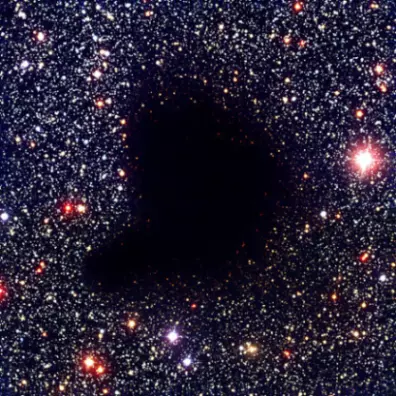
This image shows a colour composite of visible and near-infrared images of the dark cloud Barnard 68 . It was obtained with the 8.2-m VLT ANTU telescope and the multimode FORS1 instrument in March 1999. At these wavelengths, the small cloud is completely opaque because of the obscuring effect of dust particles in its interior. Image: ESO
Emerald Nebula – NGC 6572
The Emerald Nebula (NGC 6572) is a planetary nebula in Ophiuchus. It has an apparent magnitude of 8.1 and can be seen with amateur telescopes. The nebula was discovered by the German astronomer Friedrich Georg Wilhelm von Struve in 1825.
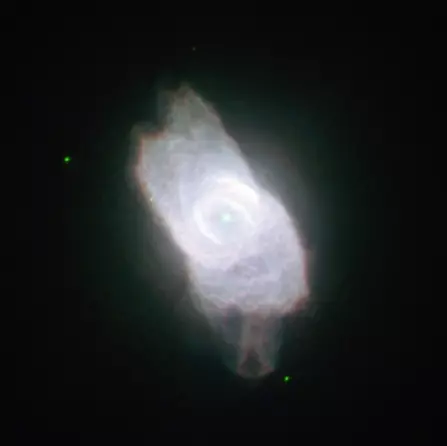
NGC 6572 only began to shed its gases a few thousand years ago, so it is a fairly young planetary nebula. As a result the material is still quite concentrated, which explains why it is abnormally bright. The envelope of gas is currently racing out into space at a speed of around 15 kilometres every second and as it becomes more diffuse, it will dim.
Image: ESA/Hubble & NASA
IC 4603-4604
IC 4603-04 is a reflection nebula in Ophiuchus. IC 4603 lies near the bright star Antares in Scorpius constellation, and IC 4604 contains several bright stars, the brightest of which is Rho Ophiuchi. The stars that illuminate the two nebulae are 400-440 light years distant from Earth.
Little Ghost Nebula (NGC 6369)
The Little Ghost Nebula is another planetary nebula in Ophiuchus. It has an apparent magnitude of 12.9 and is about 2,000 light years distant from Earth.
The nebula was discovered by William Herschel. Its main ring structure spans about a light year across and is illuminated by the central white dwarf.
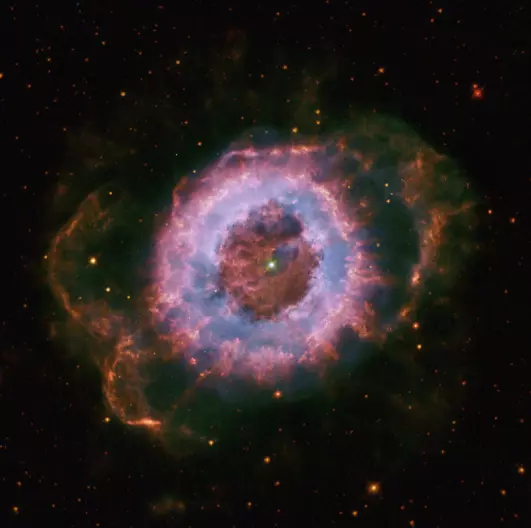
The Little Ghost Nebula (NGC 6369), image: Judy Schmidt (CC BY 2.0)
Dark Horse Nebula
The Dark Horse Nebula, sometimes known as the Great Dark Horse, is a large dark nebula in Ophiuchus.
It lies near the border with the zodiac constellations Sagittarius and Scorpius, and obscures a part of the upper central bulge of the Milky Way Galaxy.
The nebula got the name Dark Horse because its shape resembles that of a side silhouette of a horse. It is one of the largest dark nebulae in the sky. In good viewing conditions, when there is no light pollution, the nebula can be seen without binoculars.
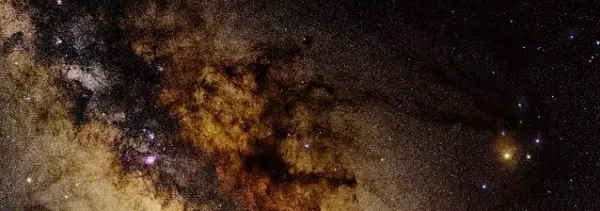
The Dark Horse Nebula, image: Hypatia Alexandria (CC BY 2.0)
Pipe Nebula – Barnard 59
The Pipe Nebula is a dark nebula which is part of the larger Dark Horse Nebula in Ophiuchus. It forms the hind quarters of the Dark Horse.
The nebula appears as a pipe shaped dust lane that obscures the Milky Way in the background. It can be seen without visual aids, but is best observed through binoculars.
The Pipe Nebula is approximately 600-700 light years distant from the solar system. It consists of two parts: the Pipe Stem, which is composed of Barnard 59, 65, 66 and 67, and the Bowl of the Pipe, which consists of Barnard 78.
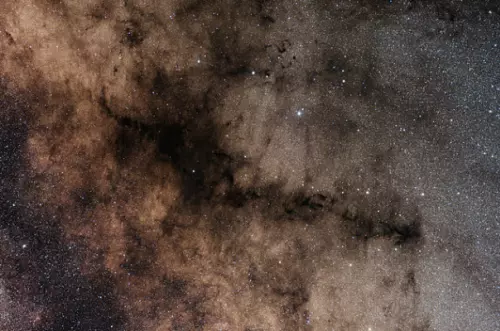
Portrayed in this image is a picturesque dust lane obscuring some of the Milky Way stars, usually referred to as the Pipe Nebula due to its curious shape. Also known under the more technical names Barnard 59, Barnard 65-67, and Barnard 78, this dark spot is visible to the naked eye in the constellation of Ophiuchus, the Snake Holder. Image: ESO/Yuri Beletsky
Snake Nebula – Barnard 72
The Snake Nebula is a dark nebula approximately 650 light years from Earth. It is small, but has a distinctive S-shape of a snake, which is how it got its name.
The nebula can be found in the north-western part of the bowl of the Pipe Nebula and is part of the larger Dark Horse Nebula. It lies to the left of the molecular cloud Barnard 68.
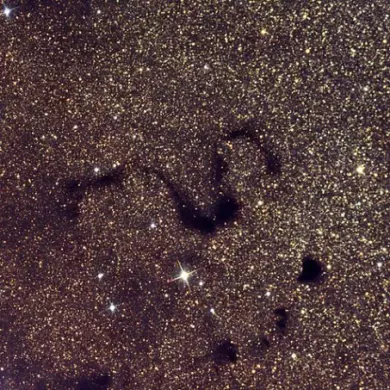
Snake Nebula, image: Wikimedia Commons/Friendlystar (CC BY 3.0)
Twin Jet Nebula (Minkowski’s Butterfly) – Planetary Nebula M2-9
The planetary nebula M2-9, also known as the Twin Jet nebula, Minkowski’s Butterfly, or the Butterfly Nebula, is another planetary nebula in Ophiuchus.
It has an apparent magnitude of 14.7 and is approximately 2,100 light years distant from the solar system. It was discovered by the German-American astronomer Rudolph Minkowski is 1947.
M2-9 is a bipolar nebula formed in the shape of twin lobes of material ejected from the central star. The shape of the lobes is believed to be caused by polar jets, which is why the nebula is sometimes called the Twin Jet Nebula.
The star at the centre of the nebula is a binary system. The primary component is the hot core of a star that ejected its outer layers and contracted into a white dwarf. The secondary component is a smaller star in a close orbit with the primary. The interaction of the two stars is what has created the nebula.
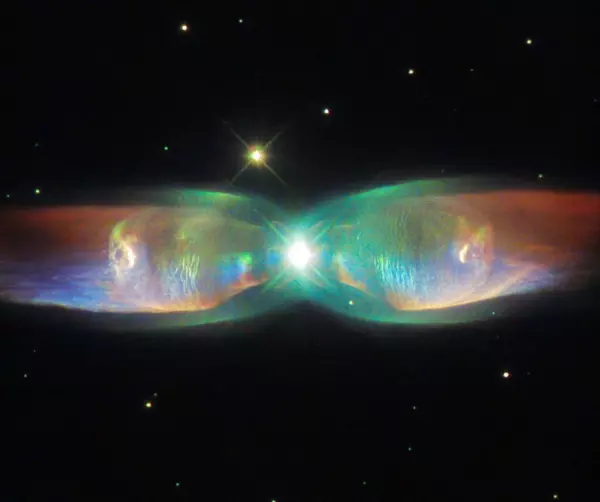
The Twin Jet Nebula, or PN M2-9, is a striking example of a bipolar planetary nebula. Bipolar planetary nebulae are formed when the central object is not a single star, but a binary system, Studies have shown that the nebula’s size increases with time, and measurements of this rate of increase suggest that the stellar outburst that formed the lobes occurred just 1200 years ago. Image: ESA/Hubble & NASA. Acknowledgement: Judy Schmidt
Rho Ophiuchi Cloud Complex
The Rho Ophiuchi cloud complex is a large region of bright and dark nebulae in Ophiuchus, located a degree to the south of the star Rho Ophiuchi. The nebula is approximately 460 light years distant from Earth. It is one of the nearest star-forming regions to the Sun.
The complex covers an area of 4.5°x6.5° and consists of two major regions of dust and gas where new stars are being formed. About 425 infrared sources, presumably young stellar objects, have been detected in one of them.
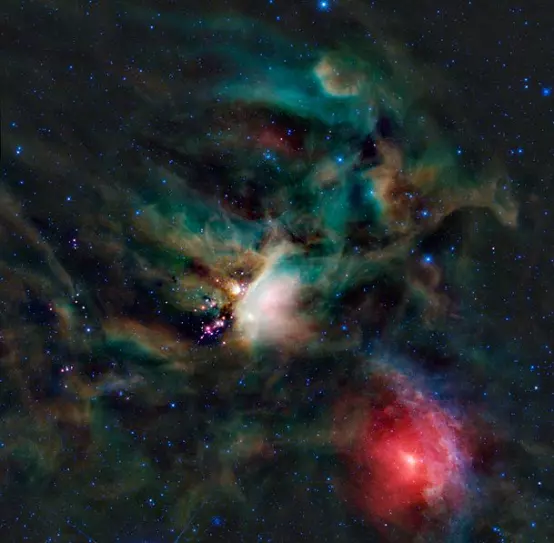
A rich collection of colourful astronomical objects is revealed in this picturesque image of the Rho Ophiuchi cloud complex from NASA’s Wide-field Infrared Explorer, or WISE. The amazing variety of different colours seen in this image represents different wavelengths of infrared light. The bright white nebula in the centre of the image is glowing due to heating from nearby stars, resulting in what is called an emission nebula. The same is true for most of the multi-hued gas prevalent throughout the entire image, including the bluish bow-shaped feature near the bottom right. The bright red area in the bottom right is light from the star in the centre – Sigma Scorpii – that is reflected off of the dust surrounding it, creating what is called a reflection nebula. And the much darker areas scattered throughout the image are pockets of cool dense gas that block out the background light, resulting in absorption (or ‘dark’) nebulae. WISE’s longer wavelength detectors can typically see through dark nebulae, but these are exceptionally opaque. The bright pink objects just left of centre are young stellar objects (YSOs). These baby stars are just now forming; many of them are still enveloped in their own tiny compact nebulae. In visible light, these YSOs are completely hidden in the dark nebula that surrounds them, which is sometimes referred to as their baby blanket. We can also see some of the oldest stars in our Milky Way Galaxy in this image, found in two separate (and much more distant) globular clusters. The first cluster, M80, is on the far right edge of the image towards the top. The second, NGC 6144, is found close to the bottom edge near the centre. They both appear as small densely compacted groups of blue stars. Globular clusters such as these typically harbour some of the oldest stars known, some as old as 13 billion years, born soon after the Universe formed. There are two other items of interest in this image as well. At the 3 o’clock position, relative to the bright central region, and about two-thirds of the way from the centre to the edge, there is a small faint red dot. That dot is an entire galaxy far, far away known as PGC 090239. And, at the bottom left of the image, there are two lines emerging from the edge. These were not created by foreground satellites; they are diffraction spikes (optical artefacts from the space telescope) from the bright star Antares that is just out of the field of view. Image: NASA/JPL-Caltech/WISE Team
NGC 6633
NGC 6633 is another open cluster in Ophiuchus, discovered by Philippe Loys de Chéseaux in 1745-1746. It has a visual magnitude of 4.6 and is about 1,040 light years distant from the Sun.
The cluster contains about 30 stars and is almost the size of the full Moon. It is about 660 million years old.
Palomar 6
Palomar 6 is a globular cluster discovered by Robert G. Harrington and Fritz Zwicky. It belongs to the halo of the Milky Way Galaxy. It is a relatively loose cluster, and one of only four globular clusters known to contain a planetary nebula.
Palomar 6 is approximately 18,900 light years distant from Earth.
NGC 6304
NGC 6304 is another globular cluster in Ophiuchus. It has an apparent magnitude of 9.03 and is approximately 19,200 light years distant from the solar system. It was discovered by William Herschel in 1786. The cluster is located near the Milky Way’s central bulge.